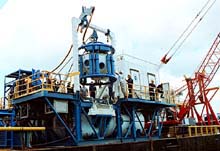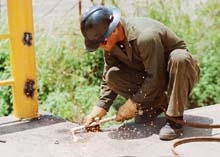
The deck of the 300 feet by 90 feet Manson Gulf barge “Wotan” fills with diving and support equipment as the Navy loads the barge for the June-July recovery of the Monitor’s steam engine. (U.S. Navy Photo). Click image for larger view.

The Global Saturation Diving System being loaded onto the “Wotan” barge for the Monitor 2001 Expedition. The Personnel Transfer Capsule or “Diving Bell” will transport saturation divers between the surface pressure chambers and the Monitor. (U.S. Navy Photo). Click image for larger view.
Hull Technician 2nd Class Petty Officer, Diver Bret Husback, a member of Mobile Diving and Salvage Unit Two (MDSU TWO), helps prepare the deck for welding a 3-inch angle iron onto the "Wotan" barge. (U.S. Navy Photo). Click image for larger view.
Monitor 2001 - Phase II
Barge Departure
June 3, 2001
John Broadwater, Manager
Monitor National Marine Sanctuary
CAPT Christopher Murray
NAVSEA, U.S. Navy
Jeffrey Johnston
Monitor National Marine Sanctuary
On Sunday, June 3, 2001, after an intensive preparation and loading phase that began in mid-May, the Manson Gulf barge “Wotan” departed the Manson facility in Houma, Louisiana, bound for the Monitor National Marine Sanctuary. Among those involved in the loadout were personnel from the Naval Sea Systems Command, Mobile Diving and Salvage Unit Two (MDSU TWO), Naval Experimental Diving Unit, Phoenix International, Manson Gulf, Global Industries and the National Oceanic and Atmospheric Administration. Final loading took place during May 28 - June 3, after which the team got underway for the Monitor National Marine Sanctuary, off Cape Hatteras, North Carolina.
During the 12-14 day transit, the Navy plans to continue final preparation of equipment and to conduct training exercises with the Global Industries Saturation Diving System. The system consists of two pressure chambers, a central “mating” chamber and a Personnel Transfer Capsule or “Diving Bell.” The principal advantage of the “SAT” diving system is that it greatly increases the amount of time that divers can spend on the bottom. The transfer capsule will transport saturation divers between the surface pressure chambers and the Monitor. At the sanctuary, four SAT divers will remain under pressure for a week or more, with each diver spending up to four hours each day working on the Monitor. Compare that four hours to the 30-40 minute limit of the surface-supplied diving methods used on previous expeditions. At the conclusion of their work period, the divers must spend several days slowly returning to the pressure at the surface.
Back in Virginia, final planning and preparations continued in the Monitor Sanctuary office, the MDSU TWO facility and at The Mariners’ Museum. The Museum is concentrating on the complex task of moving the engine from the barge to the Museum, where conservation treatment will be conducted.
Once the barge arrives at the Monitor Sanctuary, it will be secured with eight heavy anchors and positioned directly over the Monitor. At that time, diving operations will begin. Once all equipment has been tested and certified, the Navy will be conducting two separate but simultaneous diving operations, using the SAT system and a surface-supplied diving system. At any given time, as many as four divers could be on the bottom, working on the same or a variety of tasks.
But first, the barge must complete the long transit from Louisiana, around the tip of Florida and up the Southeast coast, being towed by the oceangoing tug Arapaho Eagle.
Sign up for the Ocean Explorer E-mail Update List.























